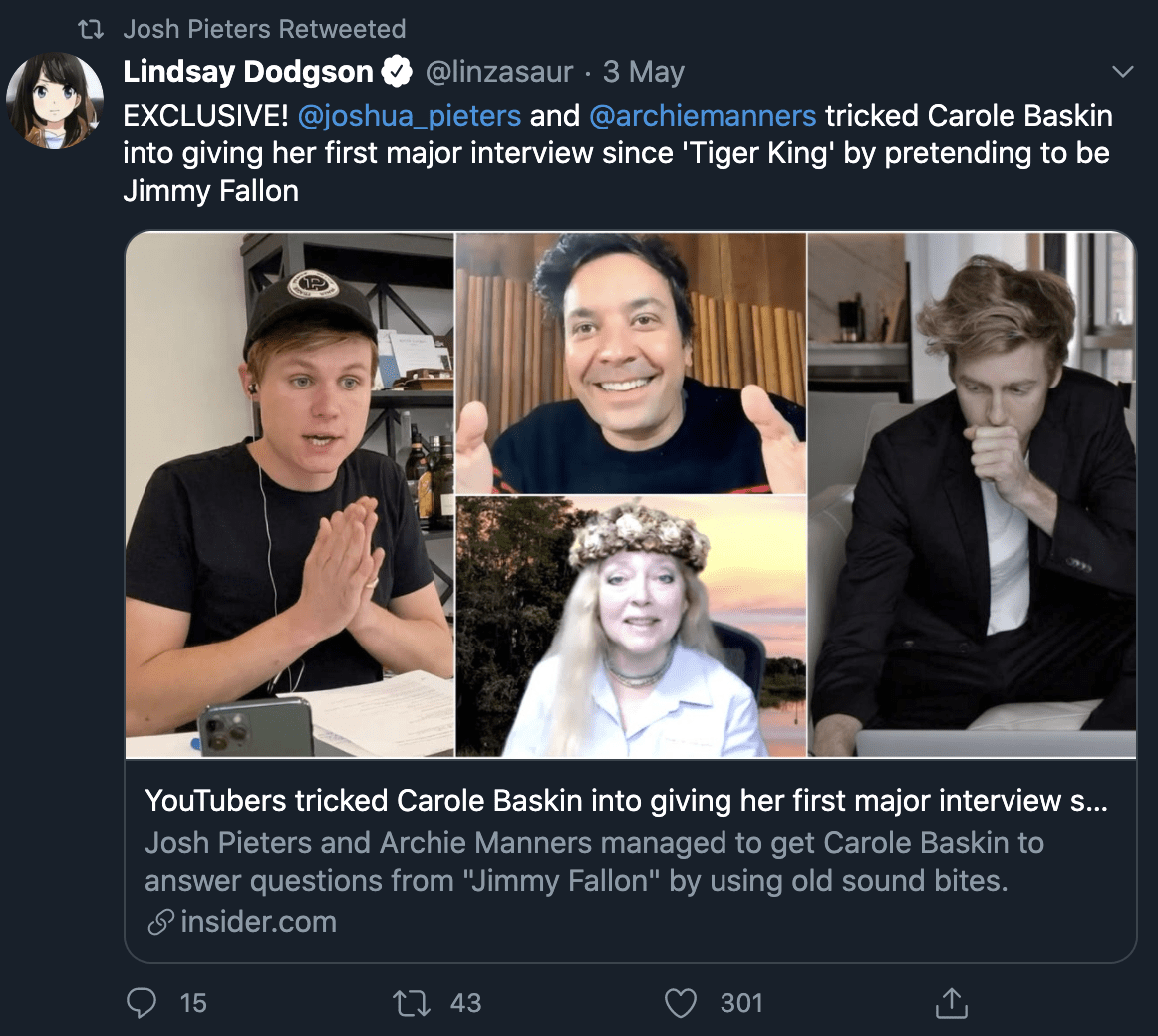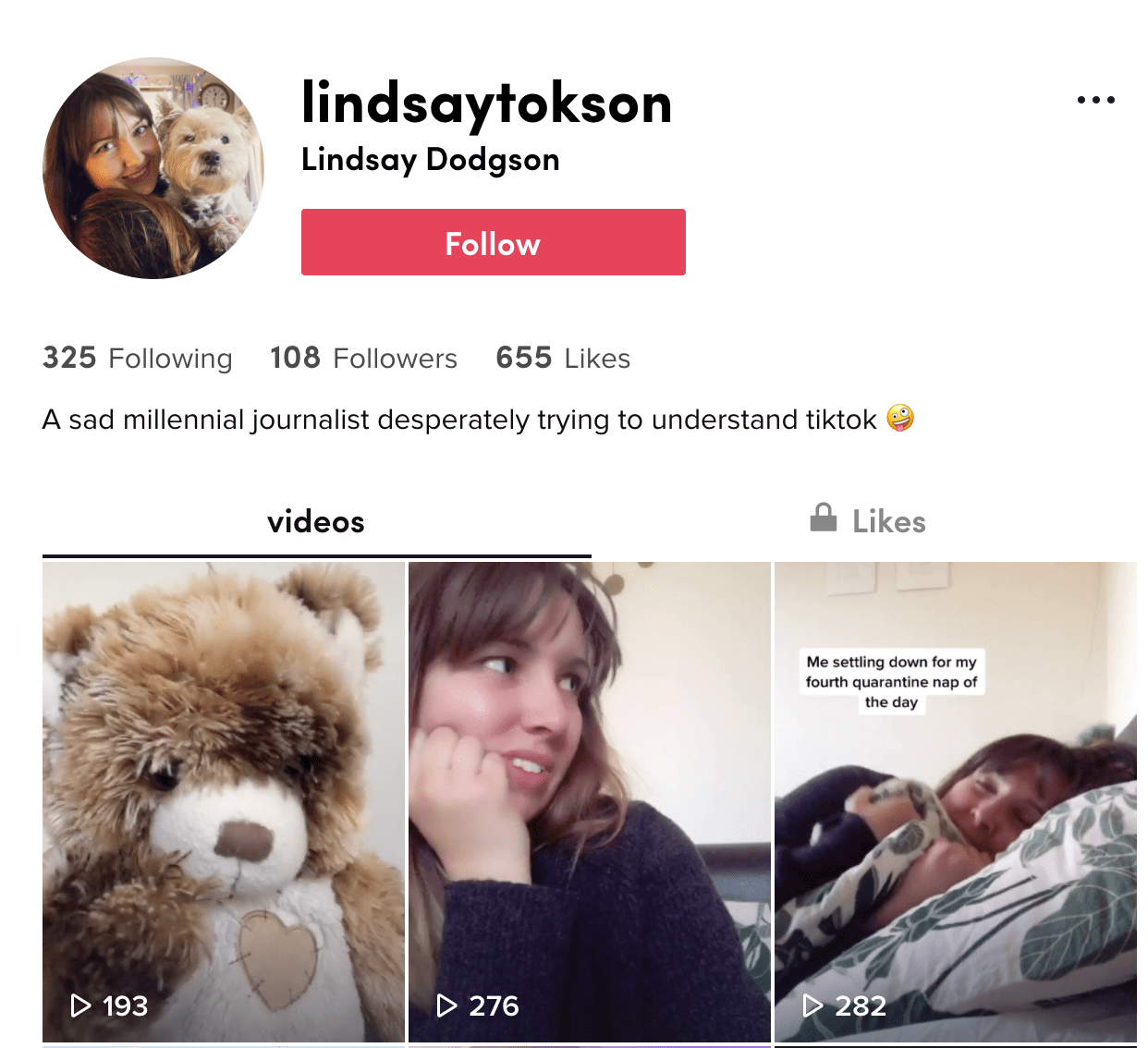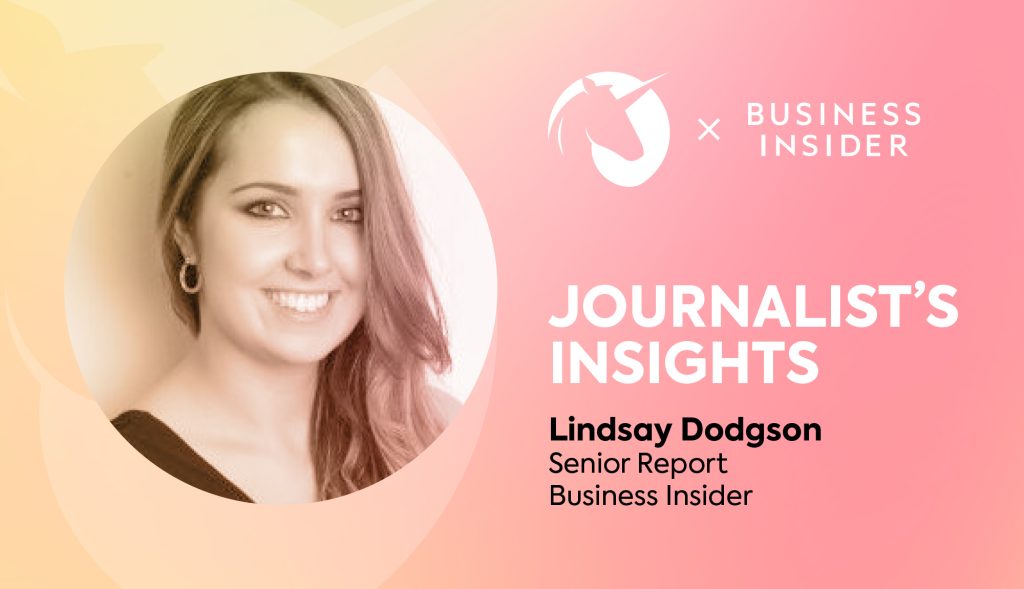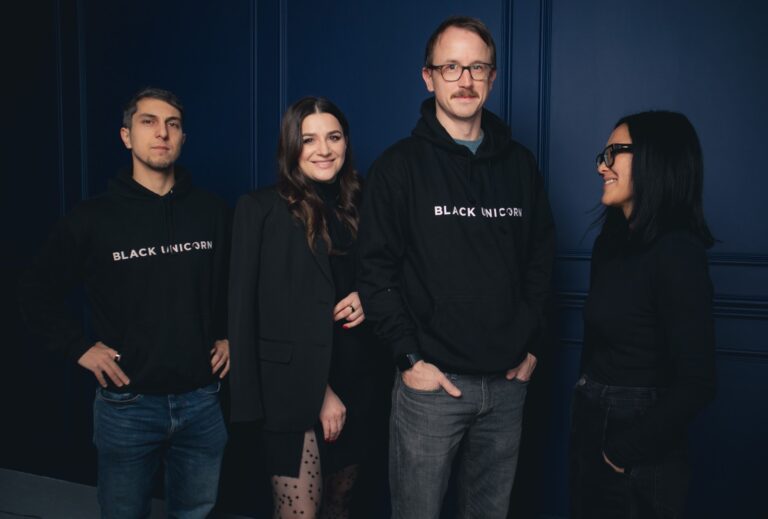Last week, we talked to Lindsay Dodgson from Business Insider for our second webinar of the Journalist’s Insights series, in which we talk to journalists about what they do and the interaction they have with PR people, startups and other businesses.
Lindsay has been a journalist for 5 years and counting, 3 of which she has spent at Business Insider, where she currently covers internet culture, human behaviour, psychology, and mental health as a Senior Reporter.
In this session, we took the opportunity to ask Lindsay about TikTok, the social media of the moment, and explored one of the most fascinating internet phenomenons: the life of the professional YouTuber. Lindsay also gave us a lot of candid advice on contacting and working with journalists.
Her answers demonstrate that not all journalists are the same in terms of their preferences, and at the same time confirmed that what all PRs need to work on in order to be successful is to be more human.
Check out our conversation with Lindsay:
- About getting an exclusive about famous YouTube pranksters tricking Carole Baskin
- How Lindsay got into journalism
- Lindsay’s current focus
- How things changes since Covid
- About Lindsay becoming a TikToker
- How Lindsay manages her inbox and scans through pitch emails
- Nice and naughty lists
- On how journalism is changing
- Top do’s and don’ts for PRs
- Wire services and their utility for PRs
- Getting calls from PRs
- What Lindsay looks out for in an email
- Length of email and attachments
- Lindsay busts some myths about journalism
- Questions from the audience
- How to get in touch with Lindsay
Lindsay, you recently had an exclusive published, an article on YouTubers tricking Carole Baskin from Tiger King into a video interview. And something odd happened, another publication in the UK wrote a piece and said they were the ones that had the exclusive. Tell us what happened there.
I cover YouTubers and internet culture quite a lot. Anything going on in the internet space I’m quite fascinated by. I have a good relationship with these two YouTubers called Josh Pieters and Archie Manners and they’re kind of pranksters, they like to do social media experiments where they see what they can get away with.
You might have seen them in the news because they gave Katie Hopkins an award recently which tricked her into having a very rude word behind her on a projector, the C word, lots of things like that. They push the boundaries, but always with the air of fun, they try not to make anyone look too bad, except if they’re like horrible racists.
Anyways the exclusive I had with them is about the story of them pretending to be working for American late night shows (think Jimmy Fallon, James Corden) pretending to book celebrities for the show. They tricked Craig David among others. But they saved the best for the last.
They managed to get Carole Baskin to agree to her first live video interview since Tiger King aired, and they used various recordings of Jimmy Fallon on air, clips of his show where he talks about cats, where he talked to a person called Cat and even from a time he interviewed a cat. So they had a lot to work with. Of course, using these clips made it a bit stop and start and awkward, and Carole was a bit suspicious about it, but it was a great story.

The guys told me about it before, and said I could post the story about half an hour before they would upload the video. So I got an amazing exclusive, I think it got read by over 600 thousand people now, which is a big hit for us. Their video has about 2 million views by now.
It’s been hard for anyone to get an interview with Carole Baskin, especially after the image we all got of her on Netflix. Although this suggests Jimmy Fallon could have had her on his show. If his team had tried, he probably would have had her on the show.
Tell us about your start as a journalist and your career.
I got into journalism five years ago. I started with science journalism, because my undergrad was zoology, believe it or not. I was studying the behaviour of animals. I guess I still am doing that because I look at humans behavior and humans are animals. I also cover mental health and other related areas.
Journalism fell into my psyche because I liked talking to people. I actually really enjoyed talking to scientists and learning about the different niches of the science world. I thought discussing science was more interesting than the practice of doing it. I hated lab work, I was never going to be an academic. I was actually rubbish at school, I was never going to be one of these people that could come up with a scientific discovery, so I turned to writing instead.
I had always done creative writing growing up, but had never thought it was something I could turn into a career. It turned out science journalism was a course at City University. It was my mum that found it, and when she told me it made perfect sense.
I did energy journalism for about a year. That’s where we met, I remember I got the name of your company wrong, so you called me about it. You were very nice about it, and then we went for coffee, so actually it was a great typo.
Then there was a job going at Business Insider for a tech journalist, so I gave it a shot and ended up there. I’ve done loads of things since I’ve been there, it’s a great place to work if you want to try different things out. Flexibility is encouraged and we are able to cover a range of topics.
And what is your main focus right now?
It’s hard to define, because it encompasses quite a lot. Our internet culture team is growing a lot. The team is mostly based in the US, but we talk with their editor.Internet culture is a growing area and the scope is huge.
My niche is to try and look at trends and wonder why things are happening, the psychology of it. If certain influencers are behaving in a certain way, what could that mean? Or, I will also look at whether there could be a mental health benefit or cost to something that’s happening. But I would also look at news about viral things and internet pranksters doing stuff.
Have things changed since Covid-19? Do you feel you and journalists in general are more busy?
Hard to say. I feel a lot more busy. I think it’s true in general. TikTok, YouTube and all social media platforms have seen a huge uptick in usage because people are bored and inside. They have nothing to do and are trying to be creative.
I guess in terms of content I am quite lucky in a way. I don’t have to cover coronavirus too much, which is good for my mental health. Obviously I see it every now and again, for example I covered ASMR videos (autonomous sensory meridian response) and how that could relieve stress from coronavirus.
If there’s a hook, it can help. Especially if it’s something that can help people. I guess I’m looking for more context within the current situation, but not always. We also want to break away from talking about this situation. We want people to have a break from it.
It helps me to sometimes have a look at funny TikToks. There’s everything on TikTok, I recently saw a woman in labour filmed by her husband. She was like ‘what the hell is he doing’. It’s a brilliant place with people doing all sorts.
As part of your assignment you had to create content for TikTok yourself. How did that go?
That was really fun. I was one of the people where TikTok was just passing me by. I knew it was a huge thing and that it had a lot of massive stars on it. The TikToker with the most followers, Charli D’Amelio, has way over 50 million now, and lots of people in her group are in the high millions too.
So my editor said “why don’t you try that out, why don’t you learn some of the dances?”. And I thought it could be quite interesting to look at some of this ‘other world’ that I would otherwise have no other reason to look at. And it was actually really eye-opening. I really enjoyed it.

Firstly I realised how hard the dances were for starters, so I have a whole new respect for some of the TikTokers. You hear so often “oh it’s just dancing”. But you know, try them, it’s tough. I was booking meeting rooms and staying in them for hours trying to learn these really basic moves, it was a disaster.
I also found TikTok to be quite friendly. For someone who spends so much time on Twitter it was nice to hear some positive comments. There’s a lot of hate on Twitter unfortunately.
So, we have a number of people interested in improving how they do PR for their startups or their clients. Not everyone knows all that goes on in the lives of journalists, the amount of work and the pressure they are after. Can you tell us a bit more about that? For instance, how many emails do you get every day?
I probably get 200 emails a day, and about 100 of those are pitches. Out of all the pitches I get, maybe one will catch my attention and be relevant.
I actually use the #journorequest hashtag a lot on Twitter. That is not a blanket rule and not everyone uses it, but I find it quite helpful, so I get a lot of pitches through there. That will be a much better payback, because they already know what I’m after. Any answers are likely to be much more relevant, they will know exactly what I’m working on and exactly what client I will need from your side.
With email, it’s a scanning game. I’m actually quite good with my email, I’m not one of those people who has thousands of unread emails in my inbox. I clear them. I actually mark them as read in bulk, so I don’t delete them. I open any emails with relevant keywords in the subject line. I also look for names that I know – PRs, sources I know or work with. I’ll mark everything else as read because I simply won’t be able to go through all of it. This is in the morning. Later on I might have more of a focused approach, because I have more time. If there’s something of interest I might pay more attention to it. But very little of it ends up being useful.
It’s difficult. I’m sure there are some good stories there. But it’s a matter of how much time I can dedicate to it. I will already have so many stories to work on, so it’s not in my best interest to dedicate more time on reading emails that will not get me anywhere.
Do you use nice and naughty lists? What do you do with journalists that keep sending you irrelevant pitches, or those that consistently send you good stuff, do those go into a priority filter?
I can’t speak for everyone, but I know certain journalists who are brutal about that. Taylor Lorenz says on her website that if PRs send an email to her non-journalist email, she will block them and their company. She must get so many that it makes sense.
I don’t blacklist people, I haven’t got lists, mainly because I’m just not the kind of person to make lists. I have a good memory though. If I find someone has been difficult to work with or annoying or has been pestering me a lot, I’ll probably ignore them.
I’m quite fortunate to be able to say that nothing ever happened to make me not want to work with a PR again. I imagine those lists definitely exist for many journalists, so I’d be careful.
One thing I find annoying is when PRs pitch things and try to shoehorn their clients into stories, I find that so annoying.
How do you think Journalism as a career has changed? With less time to meet for coffee or dinner or drinks, how do PRs become those trusted sources if you never met them before?
It’s tricky. So many of my good relationships with PRs have been on that kind of building basis. For example, we got to know each other and you know what I like and what clients are useful. You get how I think and the best way to pitch me. I find that so valuable. I do understand not everyone has that time.
If I was to get a first-time email that is a successful pitch, probably it would be the result of putting quite a lot of time into researching what I do. Looking at my author page, seeing what the recent stories are, seeing if there’s a theme, seeing if there are people I cover a lot, subjects I cover a lot, mental health and its spins, and how it would become relevant to me.
It’s also gonna be luck at the end of the day. I hate to say it. But if you put something that I cover a lot, for example, the YouTuber David Dobrik, if you put him in the subject line, I’d definitely click on it.
I cover narcissism quite a lot. I love talking about personality types and personality defaults and defects and so on. I think you’d probably know that if you look at some of my past work and see some of these themes. Again, things like psychopathy or personality types, something that is a trend I covered time and time again, I will probably click on. I guess keywords is my big takeaway here.
Also, don’t ramble on about the subject. Keep it simple, Gmail is quite smart and does flag emails that have key words that are important. But at the end of the day it is luck. I’m sorry!
What are your top do’s and don’ts?
Not a do or don’t per se, but this is a big one. A lot of PRs spend a lot of time sending a massive amount of emails. I would argue that’s not a wise way to spend your time. It would make more sense to spend more time fostering relationships and researching more what journalists their clients are truly going to be relevant for. That’s going to be so much more useful.
Even if journalists can’t cover your subject on that particular day, they will remember you as someone who can put you in touch with relevant people, because you took your time to demonstrate relevance. Those things do matter. They show you get the journalist, you get what they do and what they need.
We don’t hate PRs, that’s a myth. No. We hate irrelevant PR pitches. It’s not that bad having to clear the inbox every day. There are worse things in the world. But it could be so much better for everyone if both of us put more effort into thinking how can we both get something meaningful out of what we do on a daily basis.
Nurturing relationships is so important. I hate to use the analogy. You know the ‘give a man a fish’ thing. Say you got your press release in a publication. Great, then what? If you haven’t got the relationships, and you don’t actually understand how journalists tick, then you start again from zero. If you have nurtured meaningful relations that can result in such better stories. I’m a big believer in fostering relationships.
Staying communicative is also important, as journalists work with deadlines. We journalists are also quite bad with that actually.
What do you think about wire services? Do you use wires? Is it useful for companies to use?
I probably just ignore them. I don’t really respond to press releases. As a senior reporter, I have a bit more time to dedicate to stories I care about rather than quick hits. Before in my career, when I was a junior journalist, I was much more looking for short turnaround stuff to get up that day and build my portfolio. That’s definitely changed for me. I don’t wanna say press releases are always useless, because they’re not. But for me if you want to get a more impactful story, I would say wires are probably not worth the money.
Lots of publications do turn around press releases still. At INSIDER we talk so much about impact. We don’t just consider clips important. We consider who is reading our story and how are they affected or impacted by it, what other publications are picking up on the story and spreading it further and adding to that.
Press releases are one thing, and getting some of those media placements is good, but that’s never going to be as good as something impactful that readers will care about more. News is one thing, but a feature that mentions your client around something super interesting is another.
For example, I wrote something about female sexuality during lockdown, and built the piece around a conversation on the ‘orgasm gap’. I could have looked at who I work with and built something around their press release stuff, but rather I created a conversation about it and it’s so much more interesting. It’s a topic people like to read about because it’s impactful for them, so we focus on that, not just the agenda of the press release.
You can’t really get that kind of piece just out of a press release, unless you find the right journalist who already did their homework on something related at that point in time. And that’s where the #journorequest comes in or already knowing someone, or asking someone what stories or topics they are writing about at the moment.

We all want PRs to work with because we know you PRs have great clients. So if we know we can come to you and you have interesting people for us, that’s definitely a great thing.
Going back to wires. Mass emails are bad. Full stop. I also really don’t like it when PRs have some kind of bot set up, where they follow up periodically, and it’s obvious it’s in pre-designed intervals with words out of a template. It’s really clear you have something set up.
What do you think about calls?
I actually don’t mind a chat with a PR. I don’t feel I’m so busy or so important that I can’t have any telephone conversations with a PR.
What I hate is to pick up the phone and get someone to basically read me out the email they sent with the generic information from it. I could put the phone down and they could keep talking. Every time that happens, I just say they should send me another email. But I don’t really get around to them. Unfortunately the emails never turn out to be good.
If a pitch is good, when they send the email, it should stick. An email should be enough if it’s relevant. If you have a client and they’re really relevant to me give me a call, and I will be happy. We can chat about it even over a coffee. You don’t have to buy it for me, I don’t care about that kind of thing, I’ll buy my own coffee. Some people think we like doing that for free stuff. I would rather buy my own coffee than have hopeful people pitching me that aren’t useful.
I don’t mind phone calls that are actual conversations about working together, as opposed to demands to cover your company.
Shoehorning your clients is another of my dont’s. I know this one PR who responds to every journorequest I put out, 50% of the time it seems useful and 50% it’s not. The person keeps claiming to have the perfect client and suggests setting up a chat, but it never is. If you say you have the perfect client, make sure that’s true. Sometimes you’ll get on a phone call and half-way through you’ll be like “Oh, I can’t actually use this”. That’s not only unfair to me, it’s unfair to the client of the PR. It’s just a waste of time for everyone and disingenuous. It means also the trust is a bit broken. If you want this to work, then at least follow through with some research and effort.
What do you look out for once you open an email?
Something that’s really important for digital journalists is, we don’t just have to think about the story, we have to think about the headline, the picture, the social caption, because so much of our traffic comes from social media. It’s crazy that it’s so important.
If you as a PR can’t imagine clicking on a story and seeing it on Facebook and clicking through on it, we won’t cover it, because nobody is gonna look at it. If you can add anything to help with the framing of that, because that’s part of the battle, that’s a real bonus. If you have anything that will help make people want to click on it and see something they will really be interested in, even if it means suggesting a few headlines and adding an option of images, to see the full package, I think that’s something that can be really helpful. You don’t need to do all the job for us all the time, but it’s definitely helpful.
Also making sure it’s in our style. I still get pitches from the old Business Insider style, which used to include a lot of listicles. Many of them were great but we’ve grown up a bit since. We’re a lot more thoughtful now, but I still get a lot of pitches like “7 top films to watch about being in an office”. And it’s OK, but not something we’re really looking for right now. We still do lists, but they are a lot more detailed and thoughtful, we have real music editors and reporters adding their opinion to things and rating things. Jacob on our entertainment desk in the UK is very into TV and film, so he really adds his opinion and analysis to something. It’s not anymore ‘here’s a list of things’ but rather ‘here’s a list of things and why you should care’.
I’d say keep it short. I know there’s something to be said for having the information which is true. But I get a lot of emails which have such a depressing formatting. You can tell it’s been copied and pasted from a Word document, with nobody bothering to look through to be readable in the email. They just throw a bunch of text at you. When I see that I can’t be bothered to read it.
Would you say 3 paragraphs is the right amount of text? And what about attachments?
I don’t mind downloading stuff. I actually don’t mind having an email and the additional info separately, that’s a personal preference I think. If you can condense it down into less documents that’s great. It’s hard.
I do like a personal touch but sometimes I do get an email which will say “I Loved your article on …”, and sometimes they forget to fill in the blank, or sometimes they forget the “insert” in the email.
Just write the email yourself! That’s all I can say, be you. Be a person. I might not be interested right now, but maybe we can work in the future. I had it a couple of times in the last weeks, where someone got back to me after an exchange like that, and it’s been quite helpful, for sure.
PRs will much rather work with clients who put care and attention into their work and are reliable. The same thing in a way applies to journalists.
Alright let’s bust some myths. Myth number 1. Traditional, print media will die out soon. Is it true?
I don’t think so. Subscriptions and circulation might be going down. I think there will always be people willing to pay for print media. So many publications are doing the combined print, digital subscription to read online, get a copy. I think The Economist does that and the FT does that.
We’re only digital, so we don’t have to worry about that. I’m a digital journalist, never worked in print so my experience with print is limited. But I’m fairly positive. We’ve been hearing that print media is dying for at least the last 5 years that I’ve been in journalism, and it hasn’t.
People like having a magazine or paper, the tactile aspect of it. Me and my boyfriend used to go to the pub (back when things were normal) with a paper, because it’s a nice thing to do. I think millennials and Gen Z are a little more interested in the tactileness of things, and the retro aspect of stuff.
Myth number 2. With pressure from PR agencies all the content in journalism will be advertising in disguise.
False! There is nothing wrong with sponsored content, as long as it’s very transparent and distinguishable. We have INSIDER Picks for example. If someone clicks through to the items or things we advertise through links we get money.
I think there is always going to be room for that, and it’s a great way for journalism to make money. But people are smarter than you think. I think the whole idea of trying to smuggle sponsored content into something that looks like an op-ed, that’s never gonna pay off. That’s always gonna be shady and weird, and people realise it.
Did you see what happened on Teen Vogue the other day? It turned out to be a mistake, thank God. They published this article about the women of Facebook, I think, and it was while Facebook was going through a bad data privacy scandal. It came out as showcasing how women in Facebook were being heroes on data privacy, and quite clearly it was a sponsored ad for Facebook, under the guise of being an article or an op-ed. And it was set live by accident. It didn’t say it was a sponsored post, but that was an accident.
Smart publications don’t do this kind of thing, they know it’s not worth it. You’re going to get torn apart. Teen Vogue was torn to shreds on social media about it. In the end it turned out it was an accident. What happened was, they had an agreement with Facebook but then said they wouldn’t publish it as they would not be able to do that kind of thing. It seems that then someone still published it by accident. If it had been something they would have tried to publish without an indication of being a sponsored post that would have been so shady and awful. I think that’s illegal actually now.
I think people are too smart to want to look at content that is sponsored or advertising. And journalists have too much ego to want to do that kind of work anyway. It’s a tough one, because it’s a potential way to make money for an industry going through a lot of challenges.
Myth 3. Journalists hate PRs.
PRs can make our lives harder, but they can also make our lives much easier. It comes down to both sides, journalists too. We need you, we need you for stories, for ideas. Some of my best ideas came from talking with people like you and other PR friends, brainstorming and stuff.
We all have something to learn. Don’t hang up on people or be rude, just because they called you. It’s annoying, but you can be a bit kinder. Maybe if we’re kinder, PRs will put more time into getting to know us because we’re not so scary and then both of us will have a better relationship and a more fruitful one.
There’s definitely mistakes being done on both sides, and I see it every day. On Twitter, in the office (when we worked from the office before Covid) I could hear people complaining about PRs. But you never know when you’re gonna need them. Journalists don’t hate PRs, we hate lazy PRs. I think we should change our message, how we communicate.
Myth 4. Bloggers and journalists have the same role.
In my line of work we often used “blogging”. I do think there’s an increasingly blurred understanding of what journalism is. With blogs it feels like you are writing up about a new story or you got a quick interview with someone, and you might hear “yeah, just blog it”. Whereas with journalism I feel like it’s more about putting work into it, adding something original, investigating, talking to lots of sources. I feel like, as much as the lines are more blurred now, there still is a distinction. I guess with a blogger you don’t have a publication behind you, you are simply writing what you want.
Myth 5. Facebook and other social media are a threat to journalists.
No, I don’t think so. My opinion changed on this throughout my career. Sometimes it feels like social media is working for us and sometimes against us. It can be so dependent on their algorithm, we get a lot of clicks from Facebook.
People are on social media, and share articles, so it’s gonna be a place for people to find our work. I had concerns in the past that Facebook was trying to monopolise news, but that hasn’t happened.
From what I heard working closely with other publications is that they trust them and that they are quite good in this way. That suggests they believe outside sources are important, and that it’s not all about Facebook. I don’t wanna go into too much detail, but I think right now they are more of an asset to journalism than a hindrance. I’m sure a lot of people will disagree though.
Questions from the audience
What must a pitch cover? Should it be in bullet points?
From my perspective what can be very useful is if you have interesting stats. Numbers that can even be taken into the headline. If you’re pitching a person, as opposed to a company, include things they are willing to chat about.
I am actually interested in past coverage to understand how they have looked in the past and how interesting those were. For me it can help to sell the client.
If you use bullets, do keep them simple. I’ve seen emails where bullet points are used but they just ramble on. It becomes a paragraph per bullet point which defeats the purpose. I would say keep it short, and it should be 4 or 5 bullet points. Just add the most interesting parts of your story.
I would like to see a line at the end where you include potential angles or potential headlines to see where you’re coming from.>
Getting paid for reviews, press trips – what do you think about it from an ethical perspective? Some publications have a policy not to accept any kind of financial compensation for a press trip.
I work for one of those publications where we can’t take a press trip. It’s a policy, probably for exactly that reason. This is also to give the journalist the ability to be fully honest as opposed to accepting the press trip just to avoid not being nice. I don’t have experience with it myself but my instinct is there should be a clear boundary from the beginning.
There should be an expectation that the journalist will write what they think, and that the coverage can’t be controlled. PR companies should be aware of that too. If you’re gonna go on a press trip, that needs to be made clear. Sure, great things are likely to get written about, but if there’s something that doesn’t seem quite right, I’m gonna address it transparently.
What’s the best way to stay in touch with you?
Follow me on Twitter on @linzasaur and DM me if you think you’ve got an interesting story. I think lots of journalists don’t like it but I don’t mind it. Only if it’s actually something you know will be relevant. Don’t be afraid to call me, I might not be able to pick up, but you can suggest a chat over email. And post-quarantine we can even meet up!
Have you seen the rest of our blog yet? Here is more from our Journalist’s Insights series:
Breaking the Journalism Mould with Dan Taylor from tech.eu
Diving into fintech journalism with Doug Mackenzie from Fintech Finance
Securing media placements during COVID-19 with Yessi Bello-Perez from The Next Web



